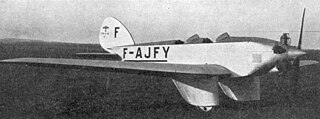Design and development
The RK.25 was noted by contemporaries for its speed, aerodynamic cleanness, its use of new light alloys and, with a range of 2,000–2,400 km (1,200–1,500 mi; 1,100–1,300 nmi), its suitability for long distance touring. It was a low wing, cantilever monoplane with an engine choice between a 80 hp (60 kW) Cirrus II or a 90 hp (67 kW) Cirrus III, both four-cylinder upright air-cooled inlines. Success in the upcoming first Challenge International de Tourisme would offer publicity and its points system benefited designs with high performance, high structural strength and low weight. [1]
Its wings were trapezoidal in plan, though with long, rounded tips. Their thickness reduced outwards, largely from below, contributing to the significant dihedral. Structurally, the wings were wooden, each with two longerons which were joined into a box spar by plywood skin out to three-quarter span; this appears dark in the photograph above. The rest of the surfaces, including the unbalanced ailerons which occupied about half the span, were silk covered. [1] The ailerons had frames of elektron, a recently developed magnesium alloy. [2]
The RK.25's upright Cirrus engine was neatly cowled in weight-saving elektron, following the upper cylinders to minimise their obstruction of the pilot's forward view. [2] The fuselage had a welded steel tube structure with fabric-covered sides and underside and a curved top which continued the narrow upper engine fairing dorsally. There were two open cockpits in tandem, one occupied by the navigator over the rear wing and the other by the pilot, behind the trailing edge. [1]
Its tail was conventional, with wooden structures and tapered, round-tipped surfaces. The elevators and the leading edges of the rudder (there was no fin) were ply-covered boxes, with silk elsewhere. The tailplane's angle of incidence could be adjusted on the ground for trimming but its elevators were unbalanced. A large balanced rudder reached down to the keel and worked in an elevator cut-out. [1] [2]
The RK.25 had a traditional fixed undercarriage with a track of 1.40 m (55 in), its mainwheels on a single axle supported by a pair of V-struts from the lower fuselage. [1] The tops of the forward V-strut members were joined transversely by a beam, free to slide vertically between pairs of fuselage members but restrained by sets of rubber rings which also circled the wing structure as it crossed the fuselage. [2]
The second RK.25 (registered D-1701) was fitted with a Cirrus III engine, [3] the improved cylinder head cooling of which [4] required a slightly wider and raised cowling. It also had raised cockpit sides. [5]
In 1932 the first prototype (D-1489) was rebuilt as the RK.25/32 for the Challenge International de Tourisme 1932. This had an enclosed cabin with large side and upper glazing panels, inboard Ksoll slotted, camber-changing flaps and independent, faired undercarriage legs. [6] It was powered by a 93 kW (125 hp) Argus As 8 air-cooled, four cylinder, inverted inline engine [7] and had a maximum speed about 240 km/h (150 mph). [6]
Operational history
The date of the RK.25's first flight is not known, though the prototype was registered in September 1928. [8] It and the second example competed in the 1929 Challenge; [9] the latter, with its more powerful engine and flown by John Carberry, came third. [10]
A third and final RK.25 was registered to Luftfahrtverein Ruhrgau (Ruhrgau flying club) of Essen in 1933. [11]
The RK.25/32 took part in the 1932 Challenge, though it was late and only admitted after the payment of a fine. [6] It performed badly in the tests before the tour, coming last of forty-one [12] and engine problems forced it out of the tour at Rimini. [13]
This page is based on this
Wikipedia article Text is available under the
CC BY-SA 4.0 license; additional terms may apply.
Images, videos and audio are available under their respective licenses.












